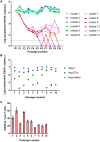Sustained Wolbachia-mediated blocking of dengue virus isolates following serial passage in Aedes aegypti cell culture
- PMID: 31191980
- PMCID: PMC6555872
- DOI: 10.1093/ve/vez012
Sustained Wolbachia-mediated blocking of dengue virus isolates following serial passage in Aedes aegypti cell culture
Abstract
Wolbachia is an intracellular endosymbiont of insects that inhibits the replication of a range of pathogens in its arthropod hosts. The release of Wolbachia into wild populations of mosquitoes is an innovative biocontrol effort to suppress the transmission of arthropod-borne viruses (arboviruses) to humans, most notably dengue virus. The success of the Wolbachia-based approach hinges upon the stable persistence of the 'pathogen blocking' effect, whose mechanistic basis is poorly understood. Evidence suggests that Wolbachia may affect viral replication via a combination of competition for host resources and activation of host immunity. The evolution of resistance against Wolbachia and pathogen blocking in the mosquito or the virus could reduce the public health impact of the symbiont releases. Here, we investigate if dengue 3 virus (DENV-3) is capable of accumulating adaptive mutations that improve its replicative capacity during serial passage in Wolbachia wMel-infected cells. During the passaging regime, viral isolates in Wolbachia-infected cells exhibited greater variation in viral loads compared to controls. The viral loads of these isolates declined rapidly during passaging due to the blocking effects of Wolbachia carriage, with several being lost all together and the remainder recovering to low but stable levels. We attempted to sequence the genomes of the surviving passaged isolates but, given their low abundance, were unable to obtain sufficient depth of coverage for evolutionary analysis. In contrast, viral loads in Wolbachia-free control cells were consistently high during passaging. The surviving isolates passaged in the presence of Wolbachia exhibited a reduced ability to replicate even in Wolbachia-free cells. These experiments demonstrate the challenge for dengue in evolving resistance to Wolbachia-mediated blocking.
Keywords: Aedes aegypti; Wolbachia; dengue virus; evolution.
Figures


Similar articles
-
Family level variation in Wolbachia-mediated dengue virus blocking in Aedes aegypti.Parasit Vectors. 2017 Dec 28;10(1):622. doi: 10.1186/s13071-017-2589-3. Parasit Vectors. 2017. PMID: 29282144 Free PMC article.
-
Wolbachia Reduces the Transmission Potential of Dengue-Infected Aedes aegypti.PLoS Negl Trop Dis. 2015 Jun 26;9(6):e0003894. doi: 10.1371/journal.pntd.0003894. eCollection 2015. PLoS Negl Trop Dis. 2015. PMID: 26115104 Free PMC article.
-
Wolbachia -mediated resistance to Zika virus infection in Aedes aegypti is dominated by diverse transcriptional regulation and weak evolutionary pressures.bioRxiv [Preprint]. 2023 Jun 26:2023.06.26.546271. doi: 10.1101/2023.06.26.546271. bioRxiv. 2023. Update in: PLoS Negl Trop Dis. 2023 Oct 2;17(10):e0011674. doi: 10.1371/journal.pntd.0011674. PMID: 37425681 Free PMC article. Updated. Preprint.
-
Wolbachia-mediated virus blocking in the mosquito vector Aedes aegypti.Curr Opin Insect Sci. 2017 Aug;22:37-44. doi: 10.1016/j.cois.2017.05.005. Epub 2017 May 10. Curr Opin Insect Sci. 2017. PMID: 28805637 Review.
-
Mission Accomplished? We Need a Guide to the 'Post Release' World of Wolbachia for Aedes-borne Disease Control.Trends Parasitol. 2018 Mar;34(3):217-226. doi: 10.1016/j.pt.2017.11.011. Epub 2018 Jan 23. Trends Parasitol. 2018. PMID: 29396201 Review.
Cited by
-
Wolbachia inhibits ovarian formation and increases blood feeding rate in female Aedes aegypti.PLoS Negl Trop Dis. 2022 Nov 11;16(11):e0010913. doi: 10.1371/journal.pntd.0010913. eCollection 2022 Nov. PLoS Negl Trop Dis. 2022. PMID: 36367854 Free PMC article.
-
A Review: Wolbachia-Based Population Replacement for Mosquito Control Shares Common Points with Genetically Modified Control Approaches.Pathogens. 2020 May 22;9(5):404. doi: 10.3390/pathogens9050404. Pathogens. 2020. PMID: 32456036 Free PMC article. Review.
-
Differences in proteome perturbations caused by the Wolbachia strain wAu suggest multiple mechanisms of Wolbachia-mediated antiviral activity.Sci Rep. 2023 Jul 20;13(1):11737. doi: 10.1038/s41598-023-38127-4. Sci Rep. 2023. PMID: 37474590 Free PMC article.
-
The infectivity of virus particles from Wolbachia-infected Drosophila.BMC Microbiol. 2025 Jan 16;25(1):25. doi: 10.1186/s12866-024-03722-6. BMC Microbiol. 2025. PMID: 39819374 Free PMC article.
-
Winning the Tug-of-War Between Effector Gene Design and Pathogen Evolution in Vector Population Replacement Strategies.Front Genet. 2019 Oct 30;10:1072. doi: 10.3389/fgene.2019.01072. eCollection 2019. Front Genet. 2019. PMID: 31737050 Free PMC article. Review.
References
-
- Aaskov J. et al. (2006) ‘Long-Term Transmission of Defective RNA Viruses in Humans and Aedes Mosquitoes’, Science (New York, N.Y.), 311: 236–8. - PubMed
-
- Asad S., Parry R., Asgari S. (2018) ‘Upregulation of Aedes aegypti Vago1 by Wolbachia and Its Effect on Dengue Virus Replication’, Insect Biochemistry and Molecular Biology, 92: 45–52. - PubMed
LinkOut - more resources
Full Text Sources

